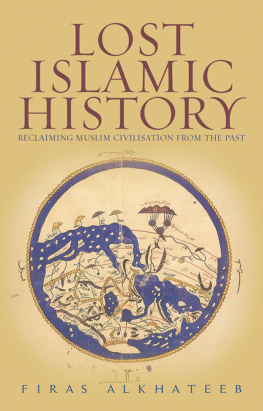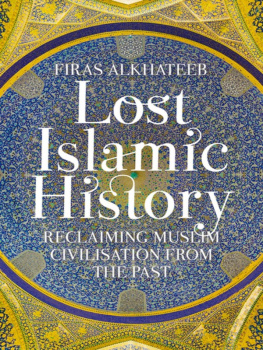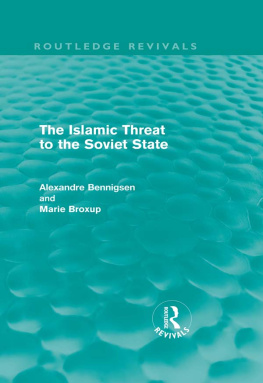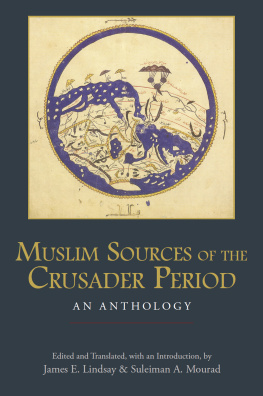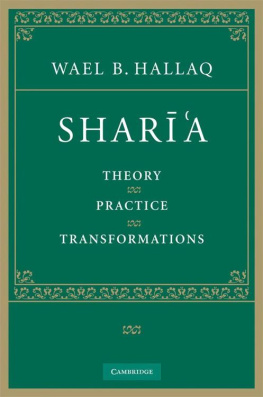LOST ISLAMIC HISTORY
FIRAS ALKHATEEB
Lost Islamic History
Reclaiming Muslim Civilisation from the Past
HURST & COMPANY, LONDON
First published in the United Kingdom in 2014 by
C. Hurst & Co. (Publishers) Ltd.,
41 Great Russell Street, London, WC1B 3PL
Firas Alkhateeb, 2014
All rights reserved.
Printed in India
Distributed in the United States, Canada and Latin America by
Oxford University Press, 198 Madison Avenue, New York, NY 10016,
United States of America
The right of Firas Alkhateeb to be identified as the author of this publication is asserted by him in accordance with the Copyright, Designs and Patents Act, 1988.
A Cataloguing-in-Publication data record for this book is available from the British Library.
978-1-84904-397-7 paperback
eISBN 978-1-84904-528-5
This book is printed using paper from registered sustainable and managed sources.
www.hurstpublishers.com
For the most important people in my life, my mother Sanaa, my wife Hadeel, and my sister Huda.

In the name of God, the Most Gracious, the Most Merciful

If anyone travels on a road in search of knowledge, Allah will cause him to travel on one of the roads of Paradise.
Prophet Muhammad
CONTENTS
The dry, mountainous landscape of the Hijaz is not an environment that gives much life. Situated in the western part of the Arabian Peninsula, this land can be described with two words: dry and hot. In the summer, temperatures regularly rise to well over 100 degrees Fahrenheit, with little precipitation. Further east, endless sand dunes mark a landscape devoid of greenery or permanent settlements. Yet it was from this harsh landscape that, in the early 600s, a new movement emerged; one that would change the course of history in the Arabian Peninsula and beyond.
Geography
The Arabian Peninsula covers an area of over 2 million square kilometers in the southwestern corner of Asia. Situated between Asia, Africa and Europe, the land is unique in its connection with all three continents of the Old World. Despite its position, it has been mostly ignored by outsiders. The Ancient Egyptians chose to expand into the Fertile Crescent and Nubia rather than venture into Arabias deserts. Alexander the Great passed by it in the 300s BCE on his way to Persia and India. The great Roman Empire attempted to invade the peninsula through Yemen in the 20s BCE, but could not adapt to the harsh landscape and thus failed to annex the region.
One could hardly blame outsiders for ignoring the Arabian Peninsula. Its dry climate is barely hospitable, even for the nomads who live there. Monsoon winds bring seasonal rains to the southern coast of the peninsula in the autumn, but these are stifled by the quickly rising landscape and never make it deep into Arabias deserts. Similarly, rains from the Mediterranean Sea barely touch upon the northern extremities of the Arabian Desert. The result is that the vast majority of the peninsula remains dry year-round. Parched riverbeds known as wadis run throughout the land, yet they are barely recognizable as rivers. When clouds gather and rains fall, they become gushing and powerful waterways, essential for the growth of the seasonal flora that manages to bloom in this dry land. Once the wet season is over, however, the wadis return to their usual, dry state, useless as sources of water. More reliable are the oasessmall fertile spots surrounded by the vast expanse of the desert. They were capable of serving host to small communities, or as waypoints for travelers, but were hardly enough to sustain an advanced and large society.
The Arabs
Civilizations tend to be greatly shaped by the environments in which they develop, and the Arabs are no exception. Everything about the life of the Arab was based around the harsh environment in which he lived. Due to the deserts inability to support settled civilization, the Arabs were constantly on the move in search of fertile land for their flocks. One theory of the etymology of the label Arab even posits that the word itself comes from a Semitic root meaning wandering or nomadic. The Arabs would spend the summer months around whatever oases or wells they could rely on year after year, trying to make supplies and water last by living on the bare minimum. After months of enduring the summer heat, they would migrate to the south, near Yemen, where rain fell in the autumn and fertile land appeared for their herds. The rain-fed pastures gave their flocks of sheep, goats and camels enough food to live off through the winter months as they pitched their tents and temporarily settled. By the time the rains stopped and the dry season began again in the spring, the Arabs returned to their oases and wells to wait out another summer. This harsh cycle had been the norm for the nomadic Arabs since time immemorial, and it remains in place for the Bedouin Arabs who still live in Arabias deserts.

In pre-Islamic Arabia, hospitality was of such importance that a guest at the home of an Arab was guaranteed at least three days of total security and protection before he would even be questioned about why he was there. This tradition was further reinforced by the Prophet, who stated that a guest has the right to be hosted for three days.

The desert was not a place to be alone. With so many threats to the survival of the Arabs, community cooperation was essential. Reliance on relatives was the first line of defense against famine and the heat that constantly threatened survival. Families were expected to share resources and shelter, and the concept of pure individualism was strongly frowned upon. As such, the family (and by extension, the tribe) served as the most important unit within Arab society. Groups of families travelled together and were considered a qabilah, or clan. Several clans would constitute a tribe, led by a tribal leader called a shaikh. Tribal identity and belonging were vital in the pre-Islamic world. Belonging to a tribe brought protection, support and economic opportunities. Tribes would go to battle to defend one of their own, and tribal warfare was unnervingly common before the arrival of Islam. Competition over grazing lands and flocks regularly brought tribes into devastating wars which could last years and extract a heavy human toll on the participants. For the Arabs, struggle was a constant, against both man and nature.
In a tribal, nomadic society like this, artistic expression becomes difficult. The resources and time necessary to complete great sculptures and paintings like the ancient civilizations of Egypt and Greece were almost non-existent. Yet the natural human desire to search for beauty could not be extinguished by the desert sands. Instead it took on a new form: language. Perhaps more than any other language in the world, Arabic itself is a form of artistic expression. Word and sentence structure is fluid, creating many different ways for a person to express the same idea. Poetry thus naturally became the de facto art of Arabia; long, epic poems glorifying tribes and heroism in war were their greatest works of art. The finest poets were revered celebrities in every way. Their words were memorized by the masses and repeated for generations. The seven most magnificent pre-Islamic poems were known as the

